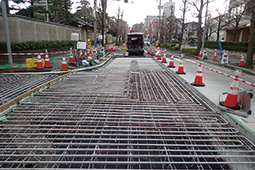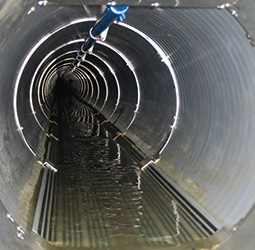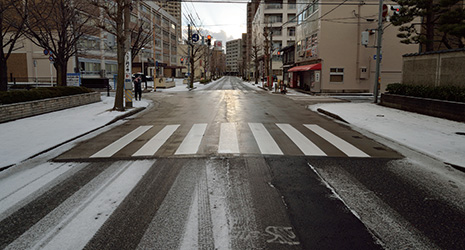INDEX

Heat radiation panels installed on a road in Niigata City, Niigata Prefecture for a demonstration test of the sewage heat snow-melting system 
A heat-collecting pipe installed under the surface of sewage in a sewer pipe (black lines)
January 2022
Using Heat from Sewage to Melt Snow on Roadways

Technology is being developed to melt snow on roadways with less energy and cost by efficiently using heat from the sewage that flows through sewer pipes.

In regions with high snowfall in winter such as Hokkaido, the Sea of Japan coast of Honshu, and mountainous areas, clearing snow from roadways is a vital task to ensure the safe transport of goods and people. The effort and cost entailed however place a significant burden on each municipality. Until now, in many cases, snow clearing in such regions has been carried out using heat—obtained by using electricity, oil, gas, etc. as fuel—from heaters or the like installed under roadways to melt the snow. However, this method is costly and has a high environmental impact.
In order to address this issue, a collaborative research body comprising Sekisui Chemical Co., Ltd., Kowa Company, Ltd., and Niigata City in Niigata Prefecture, commissioned by the National Institute for Land and Infrastructure Management (below NILIM) of the Ministry of Land, Infrastructure, Transport and Tourism, have been working to demonstrate a snow-melting technology for roadways using the heat from sewage flowing through sewer pipes (sewage heat).
“The temperature of sewage flowing through sewer pipes fluctuates with the seasons, just like the outside temperature, but a special feature is that the range of fluctuation is generally smaller than that of the outside temperature. Therefore, the temperature of sewage is lower than the outside temperature in summer and higher in winter. We can tap this special characteristic of sewage temperature to use the heat from the sewage as energy,” says Matsuura Tatsuro, senior researcher at the Wastewater System Division of the NILIM. “Sewage such as waste water emitted from homes and factories is available in stable and large quantities, especially in urban areas. A snow-melting system for roadways was developed as a way to use the heat from the sewage effectively.”

The sewage heat snow-melting system works by passing a pipe called a “heat collecting pipe” through the sewer, with the circulating liquid (antifreeze) inside this pipe then heated by the sewer heat and conducted to a “heat radiation panel” installed under the surface of the roadway, heating the road surface and melting the snow.
The key aspect of this technological development is that improvements in materials and techniques have made it possible to melt snow on roadways using less energy and at lower cost than the conventional snow-melting systems that use heaters or boilers employed to date. For example, a material with high heat conduction performance was used for the heat collecting pipes. The pump for the circulating liquid was also made more compact to achieve operating cost savings and cut power consumption. By making adjustments to the types and mixture of sand and stone for the paving material on the surface of the roadways where the heat panels are installed, the thermal conductivity can be synergistically increased.

A demonstration test conducted on a 200 square meter section of road in Niigata City center showed that this new system reduces energy consumption by more than 90 percent compared to the conventional snow-melting systems employing heaters or boilers that are mainly used now. In terms of total annual cost, the new system achieves an approximately 14 percent reduction compared to the heater method and approximately 5 percent compared to the boiler method.
“While the new system is actually more expensive to install than conventional methods, the only operating cost is the electricity to run the pump so the running cost is far lower. Also, since it doesn’t use heaters or boilers, the system emits much less carbon dioxide so is environmentally friendly,” says Matsuura.
“NILIM will also focus on initiatives geared toward extending the use of the system to other regions,” says Matsuura.
The success of this system has demonstrated that sewage from urban areas in the snow country can be used as a stable and low running cost energy source to melt snow. With the added benefit of a substantial reduction in carbon dioxide emissions, it is expected to become widely used in Japan and overseas.
Note: The sewage heat snow-melting system is part of the Breakthrough by Dynamic Approach in Sewage High Technology Project (B-DASH Project) undertaken by the Ministry of Land, Infrastructure, Transport and Tourism. The project aims to develop and disseminate innovative technologies in sewer schemes, with the national government taking the lead in conducting technical validation tests, drawing up guidelines for the introduction of the technologies. It also is aiming to deploy and expand the technologies including overseas.


